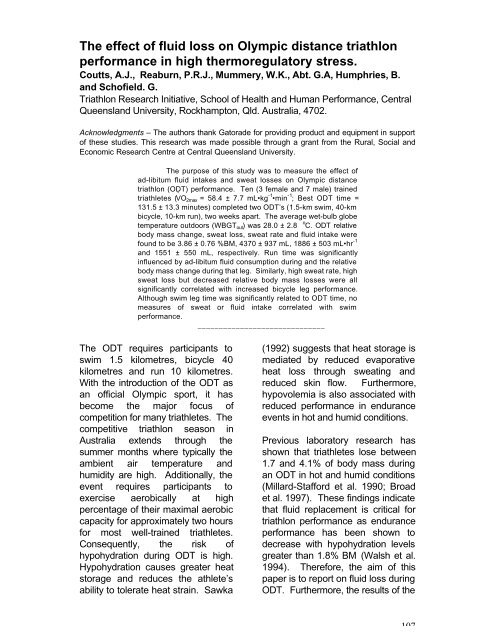MAXIMISING OLYMPIC DISTANCE TRIATHLON PERFORMANCE ...
MAXIMISING OLYMPIC DISTANCE TRIATHLON PERFORMANCE ...
MAXIMISING OLYMPIC DISTANCE TRIATHLON PERFORMANCE ...
You also want an ePaper? Increase the reach of your titles
YUMPU automatically turns print PDFs into web optimized ePapers that Google loves.
The effect of fluid loss on Olympic distance triathlonperformance in high thermoregulatory stress.Coutts, A.J., Reaburn, P.R.J., Mummery, W.K., Abt. G.A, Humphries, B.and Schofield. G.Triathlon Research Initiative, School of Health and Human Performance, CentralQueensland University, Rockhampton, Qld. Australia, 4702.Acknowledgments – The authors thank Gatorade for providing product and equipment in supportof these studies. This research was made possible through a grant from the Rural, Social andEconomic Research Centre at Central Queensland University.The purpose of this study was to measure the effect ofad-libitum fluid intakes and sweat losses on Olympic distancetriathlon (ODT) . performance. Ten (3 female and 7 male) trainedtriathletes ( V O 2max = 58.4 ± 7.7 mL•kg -1 •min -1 ; Best ODT time =131.5 ± 13.3 minutes) completed two ODT’s (1.5-km swim, 40-kmbicycle, 10-km run), two weeks apart. The average wet-bulb globetemperature outdoors (WBGT out ) was 28.0 ± 2.8 o C. ODT relativebody mass change, sweat loss, sweat rate and fluid intake werefound to be 3.86 ± 0.76 %BM, 4370 ± 937 mL, 1886 ± 503 mL•hr -1and 1551 ± 550 mL, respectively. Run time was significantlyinfluenced by ad-libitum fluid consumption during and the relativebody mass change during that leg. Similarly, high sweat rate, highsweat loss but decreased relative body mass losses were allsignificantly correlated with increased bicycle leg performance.Although swim leg time was significantly related to ODT time, nomeasures of sweat or fluid intake correlated with swimperformance.______________________________The ODT requires participants toswim 1.5 kilometres, bicycle 40kilometres and run 10 kilometres.With the introduction of the ODT asan official Olympic sport, it hasbecome the major focus ofcompetition for many triathletes. Thecompetitive triathlon season inAustralia extends through thesummer months where typically theambient air temperature andhumidity are high. Additionally, theevent requires participants toexercise aerobically at highpercentage of their maximal aerobiccapacity for approximately two hoursfor most well-trained triathletes.Consequently, the risk ofhypohydration during ODT is high.Hypohydration causes greater heatstorage and reduces the athlete’sability to tolerate heat strain. Sawka(1992) suggests that heat storage ismediated by reduced evaporativeheat loss through sweating andreduced skin flow. Furthermore,hypovolemia is also associated withreduced performance in enduranceevents in hot and humid conditions.Previous laboratory research hasshown that triathletes lose between1.7 and 4.1% of body mass duringan ODT in hot and humid conditions(Millard-Stafford et al. 1990; Broadet al. 1997). These findings indicatethat fluid replacement is critical fortriathlon performance as enduranceperformance has been shown todecrease with hypohydration levelsgreater than 1.8% BM (Walsh et al.1994). Therefore, the aim of thispaper is to report on fluid loss duringODT. Furthermore, the results of the107


